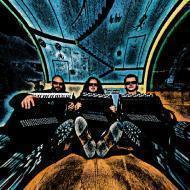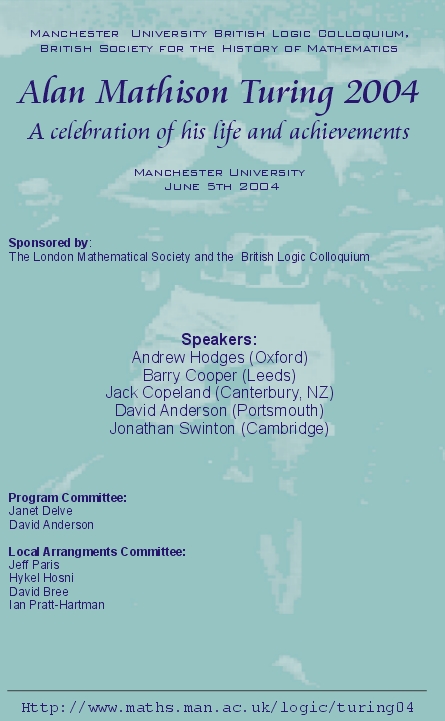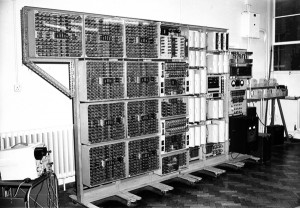Following my post about Czech Tropicala-post-punk duo DVA, I thought I’d write about some other East European-flavoured music which I listen to a lot.
The first is the album Mnemosyne, by Ljova and the Kontraband, which I have mentioned previously for their setting of poem by Joe Stickney. Their music is a mix of East-European gypsy, klezmer and jazz, played by virtuoso performers on viola, accordian, bass and percussion (plus guests). This mix could only happen in New York City, which is where they are based.
A genuine EE gypsy sound is the painful blues of Dona Dumitru Siminica (1926-1979), who sings this gypsy Romanian parallel to Rembetika in a falsetto voice, with accordian, cymbalon and bass and sometimes violin behind him. The re-issue I am listening to comprises tracks originally recorded in Bucharest in the early 1960s.
The third album brings the accordian into the 21st-century: arrangements of various fast-moving electronica tracks for a trio of virtuoso Polish accordianistas, Motion Trio. After this album, no one can ever say again that a gentleman is someone who knows how to play the accordian but refrains from doing so!

Ljova and the Kontraband [2008]: Mnemosyne. Kapustnik Records, New York City.
Dona Dumitru Siminica [2006]: Sounds from a Bygone Age, Volume 3. Asphalt Tango Records GmbH, Berlin. CD-ATR 1106.
Motion Trio [2005]: Play-Station. Asphalt Tango Records GmbH, Berlin. CD-ATR 0705.
Author Archive for peter
Page 67 of 85
Guerrilla logic: a salute to Mervyn Pragnell
When a detailed history of computer science in Britain comes to be written, one name that should not be forgotten is Mervyn O. Pragnell. As far as I am aware, Mervyn Pragnell never held any academic post and he published no research papers. However, he introduced several of the key players in British computer science to one another, and as importantly, to the lambda calculus of Alonzo Church (Hodges 2001). At a time (the 1950s and 1960s) when logic was not held in much favour in either philosophy or pure mathematics, and before it became to be regarded highly in computer science, he studied the discipline not as a salaried academic in a university, but in a private reading-circle of his own creation, almost as a guerrilla activity.
Pragnell recruited people for his logic reading-circle by haunting London bookshops, approaching people he saw buying logic texts (Bornat 2009). Among those he recruited to the circle were later-famous computer pioneers such as Rod Burstall, Peter Landin (1930-2009) and Christopher Strachey (1916-1975). The meetings were held after hours, usually in Birkbeck College, University of London, without the knowledge or permission of the college authorities (Burstall 2000). Some were held or continued in the neighbouring pub, The Duke of Marlborough. It seems that Pragnell was employed for a time in the 1960s as a private research assistant for Strachey, working from Strachey’s house (Burstall 2000). By the 1980s, he was apparently a regular attendee at the seminars on logic programming held at the Department of Computing in Imperial College, London, then (and still) one of the great research centres for the application of formal logic in computer science.
Pragnell’s key role in early theoretical computer science is sadly under-recognized. Donald MacKenzie’s fascinating history and sociology of automated theorem proving, for example, mentions Pragnell in the text (MacKenzie 2001, p. 273), but manages to omit his name from the index. Other than this, the only references I can find to his contributions are in the obituaries and personal recollections of other people. I welcome any other information anyone can provide.
UPDATE (2009-09-23): Today’s issue of The Guardian newspaper has an obituary for theoretical computer scientist Peter Landin (1930-2009), which mentions Mervyn Pragnell.
UPDATE (2012-01-30): MOP appears also to have been part of a production of the play The Way Out at The Little Theatre, Bristol in 1945-46, according to this web-chive of theatrical info.
UPDATE (2013-02-11): In this 2001 lecture by Peter Landin at the Science Museum, Landin mentions first meeting Mervyn Pragnell in a cafe in Sheffield, and then talks about his participation in Pragnell’s London reading group (from about minute 21:50).
UPDATE (2019-07-05): I have learnt some further information from a cousin of Mervyn Pragnell, Ms Susan Miles. From her, I understand that MOP’s mother died in the Influenza Pandemic around 1918, when he was very young, and he was subsequently raised in Cardiff in the large family of a cousin of his mother’s, the Miles family. MOP’s father’s family had a specialist paint manufacturing business in Bristol, Oliver Pragnell & Company Limited, which operated from 25-27 Broadmead. This establishment suffered serious bomb damage during WW II. MOP was married to Margaret and although they themselves had no children, they kept in close contact with their relatives. Both are remembered fondly by their family. (I am most grateful to Susan Miles, daughter of Mervyn Miles whose parents raised MOP, for sharing this information.)
References:
Richard Bornat [2009]: Peter Landin: a computer scientist who inspired a generation, 5th June 1930 – 3rd June 2009. Formal Aspects of Computing, 21 (5): 393-395.
Rod Burstall [2000]: Christopher Strachey – understanding programming languages. Higher-Order and Symbolic Computation, 13: 51-55.
Wilfrid Hodges [2001]: A history of British logic. Unpublished slide presentation. Available from his website.
Peter Landin [2002]: Rod Burstall: a personal note. Formal Aspects of Computing, 13: 195.
Donald MacKenzie [2001]: Mechanizing Proof: Computing, Risk, and Trust. Cambridge, MA, USA: MIT Press.
Poem: Cheyenne Mountain
Today a poem by Helen Hunt Jackson (1830-1885), a schoolmate and life-long friend of Emily Dickinson. In 1881, after moving west, she wrote an account of the US mistreatment of American Indians, “A Century of Dishonour”. On learning of her death, Emily Dickinson said: “Dear friend, can you walk, were the last words that I wrote her. Dear friend, I can fly – her immortal reply.” Today, Cheyenne Mountain hosts the underground operations center for the North American Aerospace Defense Command (NORAD).

Cheyenne Mountain
By easy slope to west as if it had
No thought, when first its soaring was begun,
Except to look devoutly to the sun,
It rises, and has risen, until, glad,
With light as with a garment, it is clad,
Each dawn, before the tardy plains have won
One ray; and after day has long been done
For us, the light doth cling reluctant, sad
To leave its brow.
Beloved mountain, I
Thy worshipper, as thou the sun’s, each morn,
My dawn, before the dawn, receive from thee;
And think, as thy rose-tinted peaks I see,
That thou wert great when Homer was not born,
And ere thou change all human song shall die!
Previous poems are here.
Computer science, love-child: Part 2
This post is a continuation of the story which began here.
Life for the teenager Computer Science was not entirely lonely, since he had several half-brothers, half-nephews, and lots of cousins, although he was the only one still living at home. In fact, his family would have required a William Faulkner or a Patrick White to do it justice.
The oldest of Mathematics’ children was Geometry, who CS did not know well because he did not visit very often. When he did visit, G would always bring a sketchpad and make drawings, while the others talked around him. What the boy had heard was that G had been very successful early in his life, with a high-powered job to do with astronomy at someplace like NASA and with lots of people working for him, and with business trips to Egypt and Greece and China and places. But then he’d had an illness or a nervous breakdown, and thought he was traveling through the fourth dimension. CS had once overheard Maths telling someone that G had an “identity crisis“, and could not see the point of life anymore, and he had become an alcoholic. He didn’t speak much to the rest of the family, except for Algebra, although all of them still seemed very fond of him, perhaps because he was the oldest brother.
Continue reading ‘Computer science, love-child: Part 2’
Learning jazz improvisation
A few days ago, writing about bank bonuses, I talked about the skills needed to get-things-done, a form of intelligence I believe is distinct (and rarer than) other, better-known forms — mathematical, linguistic, emotional, etc. There are in fact many skill sets and forms of intelligence which don’t feature prominently in our text-biased culture. One of these is musical intelligence, and I have come across a fascinating description of taking jazz improvisation and composition lessons from pianist and composer Hall Overton (1920-1972), written by Jack Reilly (1932-2018):
The cigarette dangled out the right side of his mouth, the smoke rising causing his left eye to squint, the ashes from the burning bush got longer and longer, poised precipitously to fall at any moment on the keyboard. Hall always sat at the upright piano smoking, all the while playing, correcting, and making comments on my new assighment, exercises in two-part modern counterpoint. I was perched on a rickety chair to his left, listening intensely to his brilliant exegesis, waiting in vain for the inch-long+ cigarette ash to fall. The ashes never fell! Hall instinctively knew the precise moment to stop playing , take the butt out of his mouth and flick the ashes in the tray on the upright piano to his left. He would then throw the butt in the ash tray and immediately light another cigarette. His concentration and attention to every detail of my assighment made him unaware that he never took a serious puff on the bloody cigarette. I think the cigarette was his “prop” so to speak, his way of creating obstacles that tested my concentration on what he was saying. In other words, Hall was indirectly teaching me to block out any external distractions when doing my music, even when faced with a comedic situation like wondering when the cigarette ashhes would fall on the upright keyboard or even on his tie. Yes, Hall wore a tie, and a shirt and a jacket. All memories of Hall Overton by his former students 9 times out ot 10 begin with the Ashes to Ashes situation. A champion chain smoker and indeed, a master ash flickerer, never once dirtying the floor, piano or his professorial attire.
Hall Overton, composer, jazz pianist, advocate/activist for the New Music of his time and a lover of Theolonius Monk’s music, was my teacher for one year beginning in 1957. I first heard about him from a fellow classmate at the Manhattan School of Music, which at that time was located on East 103rd street, between 2nd and 3rd avenue, an area then known as Spanish Harlem. This chap was playing in one of the basement practice rooms where I heard him playing Duke Jordan’s “Jordu”. I liked what I heard so much so I asked him where he learned to play that way. Hall Overton, was his reply. I took down Hall’s number, called him and said I wanted to take jazz piano lessons. He sounded warm and gracious over the phone which made me feel relaxed because I was nervous about playing for him. I had been playing jazz gigs and casuals since my teens but still felt light years away from my vision of myself as a complete jazz pianist. Hall was going to push the envelope. We set up weekly lessons.
Continue reading ‘Learning jazz improvisation’
Footnotes of Mad Men
For those of you enchanted with Mad Men, this site, The Footnotes of Mad Men, provides superb annotation and tangential comments.
Computer Science, love-child
With the history and pioneers of computing in the British news this week, I’ve been thinking about a common misconception: many people regard computer science as very closely related to Mathematics, perhaps even a sub-branch of Mathematics. Mathematicians and physical scientists, who often know little and that little often outdated about modern computer science and software engineering, are among the worst offenders here. For some reason, they often think that computer science consists of Fortran programming and the study of algorithms, which has been a long way from the truth for, oh, the last few decades. (I have past personal experience of the online vitriol which ignorant pure mathematicians can unleash on those who dare to suggest that computer science might involve the application of ideas from philosophy, economics, sociology or ecology.)
So here’s my story: Computer Science is the love-child of Pure Mathematics and Philosophy.
Continue reading ‘Computer Science, love-child’
Alan Turing
Yesterday, I reported on the restoration of the world’s oldest, still-working modern computer. Last night, British Prime Minister Gordon Brown apologized for the country’s treatment of Alan Turing, computer pioneer. In the words of Brown’s statement:
Turing was a quite brilliant mathematician, most famous for his work on breaking the German Enigma codes. It is no exaggeration to say that, without his outstanding contribution, the history of World War Two could well have been very different. He truly was one of those individuals we can point to whose unique contribution helped to turn the tide of war. The debt of gratitude he is owed makes it all the more horrifying, therefore, that he was treated so inhumanely. In 1952, he was convicted of ‘gross indecency’ – in effect, tried for being gay. His sentence – and he was faced with the miserable choice of this or prison – was chemical castration by a series of injections of female hormones. He took his own life just two years later.”
It might be considered that this apology required no courage of Brown.
This is not the case. Until very recently, and perhaps still today, there were people who disparaged and belittled Turing’s contribution to computer science and computer engineering. The conventional academic wisdom is that he was only good at the abstract theory and at the formal mathematizing (as in his “schoolboy essay” proposing a test to distinguish human from machine interlocuters), and not good for anything practical. This belief is false. As the philosopher and historian B. Jack Copeland has shown, Turing was actively and intimately involved in the design and construction work (mechanical & electrical) of creating the machines developed at Bletchley Park during WWII, the computing machines which enabled Britain to crack the communications codes used by the Germans.

Perhaps, like myself, you imagine this revision to conventional wisdom would be uncontroversial. Sadly, not. On 5 June 2004, I attended a symposium in Cottonopolis to commemorate the 50th anniversary of Turing’s death. At this symposium, Copeland played a recording of an oral-history interview with engineer Tom Kilburn (1921-2001), first head of the first Department of Computer Science in Britain (at the University of Manchester), and also one of the pioneers of modern computing. Kilburn and Turing had worked together in Manchester after WW II. The audience heard Kilburn stress to his interviewer that what he learnt from Turing about the design and creation of computers was all high-level (ie, abstract) and not very much, indeed only about 30 minutes worth of conversation. Copeland then produced evidence (from signing-in books) that Kilburn had attended a restricted, invitation-only, multi-week, full-time course on the design and engineering of computers which Turing had presented at the National Physical Laboratories shortly after the end of WW II, a course organized by the British Ministry of Defence to share some of the learnings of the Bletchley Park people in designing, building and operating computers. If Turing had so little of practical relevance to contribute to Kilburn’s work, why then, one wonders, would Kilburn have turned up each day to his course.
That these issues were still fresh in the minds of some people was shown by the Q&A session at the end of Copeland’s presentation. Several elderly members of the audience, clearly supporters of Kilburn, took strident and emotive issue with Copeland’s argument, with one of them even claiming that Turing had contributed nothing to the development of computing. I repeat: this took place in Manchester 50 years after Turing’s death! Clearly there were people who did not like Turing, or in some way had been offended by him, and who were still extremely upset about it half a century later. They were still trying to belittle his contribution and his practical skills, despite the factual evidence to the contrary.
I applaud Gordon Brown’s courage in officially apologizing to Alan Turing, an apology which at least ensures the historical record is set straight for what our modern society owes this man.
POSTSCRIPT #1 (2009-10-01): The year 2012 will be a centenary year of celebration of Alan Turing.
POSTSCRIPT #2 (2011-11-18): It should also be noted, concerning Mr Brown’s statement, that Turing died from eating an apple laced with cyanide. He was apparently in the habit of eating an apple each day. These two facts are not, by themselves, sufficient evidence to support a claim that he took his own life.
POSTSCRIPT #3 (2013-02-15): I am not the only person to have questioned the coroner’s official verdict that Turing committed suicide. The BBC reports that Jack Copeland notes that the police never actually tested the apple found beside Turing’s body for traces of cyanide, so it is quite possible it had no traces. The possibility remains that he died from an accidental inhalation of cyanide or that he was deliberately poisoned. Given the evidence, the only rational verdict is an open one.
Obama the policy-wonk
Andrew Sprung, over at XPOSTFACTOID, has a powerful deconstruction of the myth that Barack Obama does not do detail. Of course he does, as has been evident – from the start of his Presidential campaign 33 months ago – to anyone who actually listens to what he says. Why has the myth persisted? Partly, I think it is laziness: it is easier to repeat a cliche than to listen and think for oneself. Partly, I think it is right-wing spin: his enemies think they can paint him as an airhead, as some tried to paint Tony Blair (remember “Bambi”?).
Switch WITCH
The Guardian today carries a story about an effort at the UK National Musem of Computing at Bletchley Park to install and restore the world’s oldest working modern electric computer, the Harwell Dekatron Computer (aka the WITCH, pictured here), built originally for the UK Atomic Energy Research Establishment at Harwell in 1951. The restoration is being done by UK Computer Conservation Society.
Note: The Guardian claims this to be the world’s oldest working computer. I am sure there are older “computers” still working elsewhere, if we assume a computer is a programmable device. At late as 1985, in Harare, I saw at work in factories programmable textile and brush-making machinery which had been built in Britain more than a century earlier.

“One of the things that attracted us to the project was that it was built from standard off-the-shelf Post Office components, of which we have a stock built up for Colossus,” says Frazer. “And we have some former Post Office engineers who can do that sort of wiring.”
Frazer says he can imagine the machine’s three designers – Ted Cooke-Yarborough, Dick Barnes and Gurney Thomas – going to the stores with a list and saying: “We’d like these to build a computer, please.”
Dick Barnes, now a sprightly 88, says: “We had to build [the machine] from our existing resources or we might not have been allowed to build it at all. The relay controls came about because that was my background: during the war I had produced single-purpose calculating devices using relays. We knew it wasn’t going to be a fast computer, but it was designed to fulfil a real need at a time when the sole computing resources were hand-turned desk calculators.”